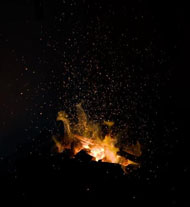Making of the Pattada's knife
 Some fundamental stages of the manufacture of the resolza pattadesa (Pattadese jack knife) have emerged during some
discussions with some Sardinian blacksmiths from Pattada. These stages can be described as follows.
Some fundamental stages of the manufacture of the resolza pattadesa (Pattadese jack knife) have emerged during some
discussions with some Sardinian blacksmiths from Pattada. These stages can be described as follows.The first thing to do is getting the horn needed for the haft: mouflon's horns were largely used because they were considered the best available; up until forty years ago finding them was easy: in fact in the woods of Mount Lerno there was plenty of such animals. The most used horns were, and still are, those of ram, but in case there was a lack of them, the blacksmiths used the horns of goat and sometimes those of ox.
Once the horn has been seasoned, the blacksmiths cuts its upper part with the scroll saw. While they do it, they are very careful not to ruin it because it is the good part that it will be used for the haft: the sides of the horn are discarded. Afterwards the horn is cleaned and heated into the forge in order to make it more malleable; when it is still warm it is put between two pieces of iron and it is cramped in order to straighten it.
While the horn cools down, the blacksmiths begin to bring the steel to a red heat into the forge, holding it with special tongs and being very careful that the metal does not exceed a certain temperature, because in the case the steel would lose its features. Once it has reached the right of temperature, while being kept still with the tongs on the anvil, the white-hot steel is forged with a hammer until it is given the shape of a blade. Once the blade has been well forged, it is refined with a file in order to give it a sharper and more elegant shape.
Then the most delicate and important stage of the process begins: the tempering of the blade. The blacksmiths carefully put the blade into the forge and they leave it until it reaches a fixed color that, depending on the quality of the steel, is usually yellow or cherry-red. Once the right temperature has been obtained, the blacksmiths remove the blade from the forge and sink it into a specific oil. Sometimes they need to “mitigate” the temperature by replacing the blade into the forge in order to heat it slowly.
At this stage the blacksmiths prepare the iron or steel arc between the two sides of the haft: they shape the haft and test the whole knife. Afterwards they drill the arc and the two sides of the knife and they fix them with small brass riveted nails.
Later they keep on working the blade with a file and a emery cloth. At this point they prepare the brass ring that keeps together the parts of the knife with a riveted nail. Then the blade i sharpened, cleaned and fixed to the haft. In the end the haft is finished off, always with a file and some sandpaper. Once the manufacture has been completed, the ring is decorated through engraving with various motives: now the knife is ready for delivery.
To view the pictures of the making of, click here.